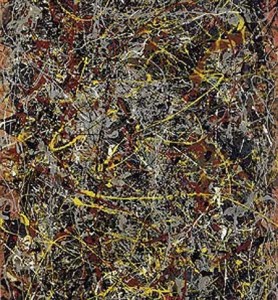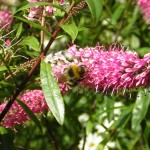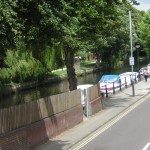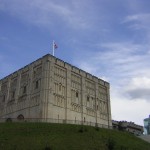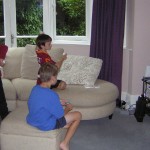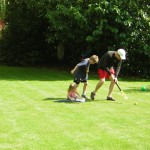It’s been a while between paper writing, traveling the world, and getting caught by a volcano….but I finally found time over spring break to sit down and reflect on my conversation on March 16 with Tom Buckham, manager at Future Radio. (and now almost a month later am finding time to actually post it in the blog)
After having spent some time interviewing and shadowing people at BBC Radio Norfolk I was ready to do a little comparison and to learn more about Future Radio, other than what I had read about on their website. So on Tuesday March 16th I used Google Maps to location the station and figure out which bus I would need to take. After double-checking with my Norwich A-Z (and confirming with my housekeeper, Tina) I discovered that the station was only a 20-minute walk down Earlham Green. I was off, and finally ready to learn more about the station, beyond the website. Winding down neighborhood streets I finally stumbled upon Norfolk Community Center in the middle of Motum Road. Taken aback a little by the size of the complex (not big by any means, but certainly a decent size for the location) I wandered around and found the entrance to Future Radio. Future Radio is a community radio station as a part of Future Projects, an organization aimed to bring art, education, and media to students aged 13-16.
Community radio stations are required to get a license through Ofcom before being established. Currently Future Radio is preparing to have their broadcast expanded from just West Norwich to the East and Southeastern parts of the city as well. This expansion is a result of being the first community radio station to reapply for, and be accepted for this expansion and license extension. Because of this re-launch, as well as the other day-to-day responsibility of being manager, Tom Buckham and I only had about 30 minutes to talk, but his information about the station was invaluable.
We initially discussed the basics of the station not covered on the website, such as: where their funding comes from, how program topics were determined, and what influences the station and their programs. I learned that roughly 165 station volunteers choose what they are going to broadcast on, based on personal interest, and the varied cultural make-up of Norwich. One of the aims of Future Radio is to be able to offer all members of the community at least one hour or so of radio that they want to tune into.
This goal allows an interest in Future Radio to build, however being a station aimed at targeting the greater Norwich community, it is challenging because they are in a category where they are ‘competing’ with stations similar in goal that have a lot more funding and are more recognizable by name, like BBC Radio Norfolk. Tom and I discussed BBC Radio Norfolk further and he said that for them it’s not comparing themselves as stations (I guess that was just my competitive American mentality, forcing a comparison), but it really is more about providing the best stations with the best programs they can for the Norwich community. He mentioned that over the past 2-3 years as Future Radio has been building as a station; BBC Radio Norfolk has been extremely supportive and helpful. Buckham also told me more about the relationship Future Radio has with the Norwich Community Council as well as the current relationship they have with the Norfolk Broads.
It was great to talk with Tom and to learn first-hand more about Future Radio (because reading about it for the past few months has not been the same). Next week [when this blog was written it was supposed to be next week…. volcano disrupted these plans.] I’m going back to the station to spend a shadow day like I did at BBC Radio Norfolk and I hope talking with more people and spending a longer period of time at the station will give me an even better idea of what Future Radio is really like.
Radio Investigation Continues A Walk Down the Street
May 8th, 2010 · 1 Comment
Tags: Amanda
The Importance of Being Earnest
March 15th, 2010 · 4 Comments
I have yet to observe the party beyond a grunt level of going door to door. So I shan’t bore you with another rousing explanation of how cold it gets after a few hours in the rain with doors being shut, albeit politely, directly in your face. However, I did get a chance to hear Adrian Ramsay give a lecture last week, so I’ll rabbit on about that instead. The talk was pretty basic, essentially just outlining a general history of the Green Party and their present day goals. Nothing a seasoned veteran wouldn’t already know. Never the less, it was a good opportunity to get some times with the demos. The Green Party has done a good job of interacting with the younger voters, especially with university students. Their Internet and forum based campaigns are more versatile and reactionary than many of the larger, more cumbersome parties out there, and they have a large portion of student or post-graduate based internal support. This support probably comes from the fact that students don’t yet have to pay for actual houses or have severe tax issues. Too that end they’re still doe-eyed and idealistic — they still believe we can insulate all the houses for free. But this seems to be a common thread for many of the smaller parties. When a party doesn’t have actual power, they just promise to give lots of door prizes — just look at the Lib Dem’s campaign.
Despite Green Party’s focus on young voters, I found it strange to see how hard Mr. Ramsay attempted to dissociate himself from our age group. He is definitely older than me, but seven years tops (he was elected in 2003 at the age of 21), which in political terms is practically nothing. He may have been doing this in an attempt to legitimize himself, to be looked up to, or he may realize he needs to be focusing more on the more middle class/middle age votes.
This last idea scares me: we are constantly being driven further to the center. New Labour knew it, Cons definitely know it. The Conservatives will pretty much get every vote right of center withing the first and possibly second standard deviation, therefore, they need to put their policy as close to the center as possible as a means of snatching up as many votes as possible. Labour did this as well, although it later cost them by creating a split into Lib-dems and Labour. I see the Green Party of Britain and Wales becoming more formalized, which is partially a good thing. It means they have better organization, more potential funding and actually have a chance of winning seats. But it also means there is a potential slip in ideological stances; it means the green party could start shifting to the middle and lose its initial purpose. I don’t foresee this truly happening as the green party still relies on wedge issues, but it is a potential outcome.
Does the Green Party really have a chance at winning though? Honestly, I don’t think this time around, which saddens me. I will say this, the Green Party has gone from 1.4% to 7.4% in three election. This could simply be a reactionary movement away from labour, as most of the votes were taken from said party. But you know what, a votes a vote. First passed the post is a war of attrician, greens might not win this time, but i bet they’ll be in the top three this time. The election is potentially coming up soon (May 6th), so I guess we’ll find out soon enough.
Also of interesting note: the Sunday before break, there will be a Q&A session with four of the Norwich South candidates, seats are still open if you’re interested, but you’ll also be able to watch it on TV. Check it out, might even spot me!
Cheers
Tags: Andrew R
Tour of the Great Hospital
February 26th, 2010 · 1 Comment
Several weeks ago, Audrey, Kelley, Chelsea and I took a tour of the Great Hospital which was given by a member of the Board of Trustees for the Hospital, Pam Petersen. Pam, a vivacious elderly woman with a quirky yet endearing sense of humor, proved to be a wealth of information regarding the Hospital, medieval life, and fun, strange facts about Norwich and Norfolk.
The tour began in the Church of St. Helen, a small, modest church which was, at the time it was built, one of the most impressive church buildings of its kind in the city. As The Great Hospital, originally St. Giles’s, underwent multiple renovations and restorations, certain areas of the church were walled off and transformed into hospital wards. Pam pointed out several interesting features within the Church, including the elaborately decorated vaulted bosses in the chantry chapel, a special stained glass window and carved wooden bench ends. The bosses are all hand-carved, hand-painted, and depict significant biblical scenes. The stained glass window was donated from a church which was largely destroyed during the air raids on Norfolk during WWII. Amazingly, the window survived, and now rests within the walls of the Church. The bench ends were carved by John Hecker between 1519 and 1532, and are fine examples of medieval woodworking.

From the Church of St. Helen, Pam led us into Eagle Ward. Eagle Ward was formed as a result of the renovations previously mentioned, and was converted into accommodation during the mid-fifteenth century, and served as such up until the first part of the twentieth century. The ceiling of the Ward is adorned with 252 tiles, each painted with an eagle. The creation of the ceiling was to celebrate the coming of Anne of Bohemia, the wife of King Richard II, to Norwich. Today, the Ward serves as an exhibit and is preserved to look as it would have in the first part of the twentieth century, complete with tea cups, doilies, reading glasses, bed pans and other period artifacts that would have belonged to the residents who lived there.
We moved on to the Refectory, which is where the priests of the medieval hospital would have taken their meals, and where events, meetings and small banquets are still held today. The ceiling of the hall is supported by exposed beams which feature carved dragons, similar to those which can be seen in nearby Dragon Hall. An antique table stands at the back of the room and was cut from a single tree. The table is very unique and quite valuable, according to Pam. Among other artifacts, including banners and framed documents, the Refectory houses a slightly more grotesque artifact: a goose quarterer. St. Giles’s was known for their annual goose feasts, and even boasted its own swan pit. The walls of the Refectory are lined with photographs of feather-plucking – which was, according to one caption, a social affair – and charts depicting the various branding marks which would be cut into the beaks of the swans.
As we left the Refectory and made our way to the Ivory Room, Pam spoke about the current operations at The Great Hospital. Currently an assisted living facility, the hospital houses 126 residents and offers three different types of care: independent with no care, independent with some care (help with dressing, household chores, etc.) and full care. However, there is no nursing service offered by the hospital.
The Ivory Room, actually a house in its own right, was built and restored by the Thomas Ivory family, with whom the hospital maintained a close relationship. The building is quintessentially Georgian, and features Roman style murals and trompe l’oeil throughout. The Ivory Room is currently undergoing major restoration, but the grandeur of this magnificent building is discernible even through the scaffolding and littering of paint cans and toolboxes. In a room which faces the Norwich Cathedral, painted cherubs adorn the silk-lined ceiling, and the entire celestial scene is lined with crisp crown mouldings.

From this room in the Ivory Room, I looked out onto the steeple of Norwich Cathedral, slightly silhouetted against a pink-grey sky. It seemed like the perfect location – and ambience – in which to end our tour. Before wrapping up our tour, Pam shared with us a recipe for Swan, laughing all the while. We made small talk as she showed us back out to the road, and asked us where we were all from. We answered and Pam responded that the only American geography she knew she had learned from The Simpsons. We, laughed, thanked her and walked along Pottergate, under the Norwich sunset.
Length of tour: approx. 1.5 hrs. Total time logged: 2.5 hrs.
Tags: Anya
When the Music and the body become one
February 23rd, 2010 · 1 Comment
“Head down, as I watch my feet take turns hitting the ground”……. The Instructor tells me to look in his eyes, never at the ground, because you never know when your opponent can strike. As a Capoeirista you owe it to yourself, the instructor, your opponent, the Bid-im-bow, and the Rhoda to focus and properly carryout the culture of Capoeira. My first day of Capoeira was about 5 months ago, but I still remember that class as if it was yesterday. I walked into class really not knowing what to expect, other than a few sightings and Venice beach and playing the game Tekken, with Eddy Guardo being one of my favorite characters, I really wasn’t sure what Capoeira was.
The only reason why I entered the class in the first place was because a few days before, I was informed about the signing up for Societies in the LCR. Apart from ACS (Afro-Caribbean Society) nothing really caught my interest, until a student jumped out in front of my face and said, “Ever try Capoeira.” Instantly my mind took me back about a good 12 years when I was at the beach with my family. I was running around in the sand, burying one of my Spiderman toys when I heard faint drumming in the distance. Normally I equated the sounds of drums to West African dance because I had been trained in it since the age of four. But as my feet coerced themselves into the sand the noise became louder. Once I arrived at the sound I discovered a circle of people looking like they were “break dance fighting.” I immediately became intrigued, flares, kicks, and a rhythmic swaying contributed to this foreign sight where the music and the body served as the inspiration for the movement. Once I returned back to my reality I put my name on the list immediately.
Walking into that class that day took me all the way back to when I was 8 because I was going in with the exact same curiosity. We began class by running around and getting our cardio up. We warmed up each of our muscles carefully and attentively as to not betray our bodies because in the latter part of class we would get more physical. As we went through the warm up I realized that Capoeira was going to feel very familiar to me, because as a dancer I was used to moving my body with the sound of music, I would just need to learn this new style and adapt to the movement and music as best as I could.
The instructor gave us the basic movement a swaying motion back and forth switching you weight from right to left, this movement is called “GInga.” The Ginga is the most fundamental part of Capoeira because it provides you the basic fundamental movement that you need in order to play Capoeira. The second major purpose of the Ginga is that it determines your own style, and no one persons Ginga is the same as another’s and once you have acquired your own Ginga you can begin to further explore the culture of Capoeira. Of all the classes I have taken the first one was my favorite because it seemed like second nature, and the instructor really challenged me to push through and not be inhibited by those more advanced than myself.
In the last portion of class the instructor gathered us all up in order to form a “Rhoda” (the circle in which Capoeira takes place. He named the various instruments used in the “Rhoda” some familiar some foreign and discussed the importance of the songs and the role they play in Copoiera. Once we learned a few hymns two people bent down, faced each other in the Rhoda, cart wheeled in and my curiosity began to take me on my journey. I was infatuated with the whole culture of Capoeira, and as the music and body became one, a new vocabulary of movement was opened up to me that I had not yet known existed.
Tags: Anthony · Uncategorized
That’s What it’s All About?
February 17th, 2010 · 2 Comments
Have you ever found yourself in a moment where you question everything? Where you reconsider everything you thought you knew? Well that happened to me today as I was reading one of the books I’m using for my research paper, Talking Prices. This book is an examination into the world of pricing contemporary art. As I read, I began to think about how much the art world is concerned with money… and how much I am not. Now, I know money is important and that it’s involved in almost every aspect of our lives, but I’m not interested in art for a profit. I love art, plain and simple. I love the feeling I when I discover a new artist, or when I see a work in a museum that I have studied in an art history course (ask Kelley about our visit to the National Gallery in London). I’m sure most people who are established gallery owners, dealers or curators thought the same thing, that they would never let their artistic priorities be compromised by commercial objectives or let financial matters interfere with the way they establish relationships with artists, but I’m sure that has changed. In a discipline where one is constantly bombarded with words like ‘provenance’, ‘price’ and ‘worth’ how could you not let it affect the way you see art? I am still leaning how art is priced, and I am still amazed that one painting can sell for one hundred and forty million dollars (Jackson Pollock’s No. 5, 1948). While selling prices at auction houses like Sotheby’s are fascinating, I don’t think it’s the only way to determine worth. One of my big questions is, how does the price of a work relate to its aesthetic quality? Call me naive, but I don’t want to turn into another person who just sees a big price tag instead of a work of art. But the end of my interview session with Norwich gallery owners I hope to have a few of my fears confirmed or laid to rest. In these interviews I have been trying to determine what kind of contemporary art market Norwich has. So far it seems to be a mix of so-called ‘traditional’ and ‘avant-garde’ spaces, quite like the inhabitants of this ‘fine city’. While some gallery owners have said there is a decent market in town, others are less than optimistic. I received an email from one of my contacts yesterday that stated, in fact, there is NO market for contemporary art in Norwich.
“As well as owning the gallery, I am an architect and it is this profession that has kept the gallery going. I’ve been working in Jersey (Channel Islands) for the last year, which is why the gallery has only had 2 shows in the last year…so the simple answer to your question is that contemporary art does not sell in a place like Norwich!”
But I still have hope! We’ll see if my constant optimism proves to be my demise.
Another realization: (and this is one that seems to be true across the boards) the more I learn about life, that more it seems that it’s not WHAT you know but WHO you know. Even with a Dickinson education, networking is essential. The whole art business is a giant web of relationships between artists, dealers and collectors. Lucky for me, I’ve inherited my father’s schmoozing skills and the ability to make friends easily. Now it’s time to put them to good use. People always tell you that best job is one that doesn’t feel like work, and I hope I can achieve this someday. But for now I’m going to have to work my way up the ladder. The art world is no place for introverts and if you want to stand out, you need to start networking early. Sound cutthroat? That’s because it is.
Tags: Grace
Scouting in the U.K. Part Two
January 29th, 2010 · 2 Comments
This evening I attended my second Explorer Scout Meeting. I was driven to the last meeting so this was the first time that I had to find the location on my own. Utilizing Google Maps and my Norwich A to Z to their fullest I calculated that it would actually be faster for me to walk to the meeting instead of taking a 21 or 22 bus (23 minutes vs. 29 minutes). This seemed like a great idea until it started, snowing, raining, sleeting etc. Nevertheless I bundled up, braved the elements and trudged my way over towards Bowthorpe Road hoping for the best.
Upon arrival (5 minutes early!) I greeted the troop leader, Lesley, and the scouts that I had met at the previous meeting. Glad to be inside I shed a few layers and prepared for the opening ceremony. When I was home over winter break I decided to bring my scout shirt back with me to wear at meetings/other events. The scouts found it very interesting and we spent a considerable amount of time discussing the similarities and differences between my uniform and theirs.
After witnessing a flag ceremony I was informed that the scouts would be working on making/decorating troop t-shirts at the meeting. My primary job consisted of cutting out cardboard squares for the scouts to mount their completed t-shirts on. This was so the paint they were using to decorate them would dry easier. This task took me longer than I expected since my pocketknife was getting a little dull.
As the scouts were decorating their t-shirts I chatted with them about various subjects. Two weeks ago the scouts attended Wintercamp at Gilwell Park, just outside of London. Since I plan on visiting Gilwell within the next few weeks I asked the scouts about their winter camp experience and about the park itself.
One scout was decorating his t-shirt in the colors of Norwich FC because he is a big fan. When I informed him that I was attending the Norwich vs. Hartlepool match tomorrow he was quite jealous.
We also spent a lot of time talking about education in the U.K. since a few of these scouts are preparing to take their A-Levels. They asked me what I was studying at UEA and if I was enjoying my time in England. Many of the scouts had very different academic interests but all seemed pretty sure of what they wanted to do as a career. I found this interesting. When I was 16 or 17 I had absolutely no idea what I wanted to major in at College, let alone know what I wanted to do for the rest of my life. Even now I am unsure/change my mind from time to time. Since many of the students that I have met at UEA seem to have their future planned out as well I wonder whether it is simply a cultural phenomenon that American students are generally not as decisive at an early age as English students when it comes to careers. Maybe it was just that I, and many of my friends, knew that we wanted to attend liberal arts colleges but I think I am on to something here.
After cleaning up all the supplies I witnessed an awards ceremony and we concluded the meeting. I was given a “Programme of Events” for the rest of the spring so now I know what the scouts will be working on from meeting to meeting. After saying goodbye to everyone I put back on my layers and made my way back out into the cold. Having found my way there I knew my way back comfortably and walked at a brisk Kelley pace, returning to the village in just under 20 minutes.
Although I hurried back to the village because of the cold I realized on my walk back that I would really like to explore more of Norwich, especially the parts outside of the city centre. As I spent more and more time at Dickinson I began to walk around and explore Carlisle a little bit and actually stumbled upon some pretty cool things. I’m sure Norwich will have similar if not greater surprises waiting for me. Once the weather warms up this will be my adventure.
Volunteer Hours: 2.5
Total: 5.5
Tags: Henry
Your new home
August 2nd, 2009 · 3 Comments
We are trying to get around the city (and surroundings) of our new home. Thought you might like to see some photos.
- Backyard flora
- Dickinson House (aka Thaneway House)
- City Center
- Riverwalk
- Train station
- Norwich Castle
- Wii Tournament anyone!?
- Americana in the back yard
Tags: Uncategorized



